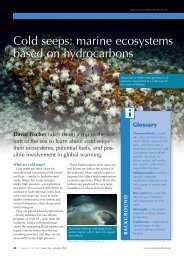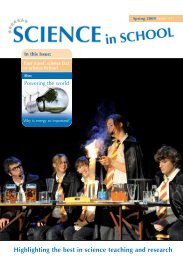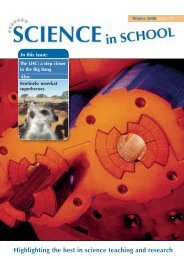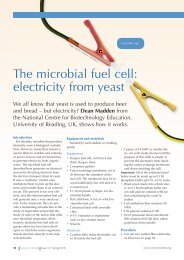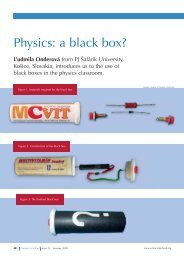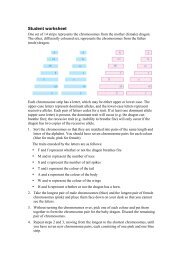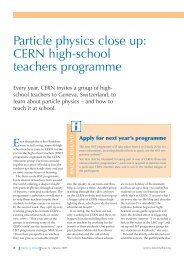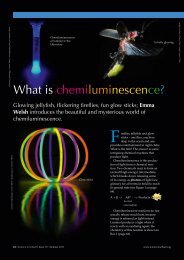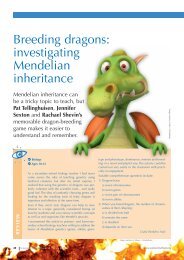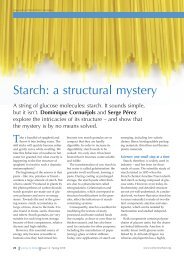Download Issue 14 as PDF [5.4 MB] - Science in School
Download Issue 14 as PDF [5.4 MB] - Science in School
Download Issue 14 as PDF [5.4 MB] - Science in School
You also want an ePaper? Increase the reach of your titles
YUMPU automatically turns print PDFs into web optimized ePapers that Google loves.
Cutt<strong>in</strong>g-edge science<br />
cals were not distributed throughout<br />
the seaweeds evenly. Instead, they<br />
were spread out <strong>in</strong> patches along the<br />
seaweed surface. These patches were<br />
also covered with sediment and particles<br />
that had been float<strong>in</strong>g about <strong>in</strong><br />
the water.<br />
Kubanek and her colleagues reported<br />
<strong>in</strong> The Proceed<strong>in</strong>gs of the National<br />
Academy of <strong>Science</strong>s USA l<strong>as</strong>t year that<br />
they believe the seaweed is creat<strong>in</strong>g<br />
its own version of a scab. As the seaweed<br />
gets cut, attacked or abraded,<br />
they believe it oozes sticky carbohydrates<br />
rich <strong>in</strong> antimicrobial chemicals<br />
from <strong>in</strong>side. These chemicals then<br />
prevent the seaweed from becom<strong>in</strong>g<br />
<strong>in</strong>fected and the sticky ooze collects<br />
float<strong>in</strong>g particles from the water<br />
to cover up the <strong>in</strong>jured area.<br />
This sort of behaviour h<strong>as</strong><br />
never been seen before <strong>in</strong> seaweed,<br />
but the authors suggests<br />
that it may be similar <strong>in</strong><br />
function to the res<strong>in</strong> that p<strong>in</strong>e<br />
trees ooze when cut.<br />
Practically, the f<strong>in</strong>d is important<br />
for develop<strong>in</strong>g pharmaceuticals<br />
that can help wounds heal,<br />
but from a grander ecological perspective<br />
it is no more or less important<br />
than the discovery of new bonefeed<strong>in</strong>g<br />
worms or of<br />
the use of elephant faeces <strong>as</strong> accommodation.<br />
Indeed, just when it seems<br />
<strong>as</strong> if the world’s biodiversity could<br />
not possibly become any richer,<br />
researchers prove that it can.<br />
Acknowledgements<br />
The author would like to thank<br />
Drs Vrijenhoek, Campos-Arceiz<br />
and Kubanek for tak<strong>in</strong>g the time<br />
to proofread this work and for<br />
provid<strong>in</strong>g valuable feedback.<br />
Image courtesy<br />
of bedo<br />
/ iStockphoto<br />
Image courtesy<br />
of adi7 /<br />
iStockphoto<br />
Image courtesy of amwu /<br />
iStockphoto<br />
Resources<br />
To read more about the discoveries described <strong>in</strong> this article,<br />
read the published research:<br />
Campos-Arceiz A (2009) Shit happens (to be useful)! Use<br />
of elephant dung <strong>as</strong> habitat by amphibians. Biotropica 41:<br />
406-407. doi: 10.1111/j.1744-7429.2009.00525.x<br />
Lane AL et al. (2009) Desorption electrospray ionization<br />
m<strong>as</strong>s spectrometry reveals surface-mediated antifungal<br />
chemical defense of a tropical seaweed. Proceed<strong>in</strong>gs of the<br />
National Academy of <strong>Science</strong>s 106: 73<strong>14</strong>-7319. doi:<br />
10.1073/pn<strong>as</strong>.0812020106<br />
Vrijenhoek RC, Johnson SB, Rouse GW (2009) A<br />
remarkable diversity of bone-eat<strong>in</strong>g worms (Osedax;<br />
Sibogl<strong>in</strong>idae; Annelida). BMC Biology 7: 1-13. doi:<br />
10.1186/1741-7007-7-74<br />
BMC Biology is an open-access journal, thus all articles<br />
are freely available onl<strong>in</strong>e.<br />
For more <strong>in</strong>formation on the International Year of<br />
Biodiversity, see: www.cbd.<strong>in</strong>t<br />
The website <strong>in</strong>cludes a manual for educators, Biodiversity<br />
is Life: www.cbd.<strong>in</strong>t/iyb/doc/partners/<br />
iyb-waza-manual-en.pdf<br />
If you enjoyed this article, you might like to browse all science<br />
topics previously published <strong>in</strong> <strong>Science</strong> <strong>in</strong> <strong>School</strong>. See:<br />
www.science<strong>in</strong>school.org/sciencetopics<br />
Matt Kaplan is a professional science journalist, b<strong>as</strong>ed <strong>in</strong><br />
both London and Los Angeles, who regularly reports on<br />
everyth<strong>in</strong>g from palaeontology and par<strong>as</strong>ites to virology<br />
and viticulture. When not stuck beh<strong>in</strong>d a desk, he runs<br />
wilderness expeditions <strong>in</strong> far-flung regions of the world.<br />
See: www.scholarscribe.com<br />
For this <strong>Science</strong> <strong>in</strong> <strong>School</strong> article, Matt waived his usual<br />
writ<strong>in</strong>g fee.<br />
www.science<strong>in</strong>school.org <strong>Science</strong> <strong>in</strong> <strong>School</strong> <strong>Issue</strong> <strong>14</strong> : Spr<strong>in</strong>g 2010 31


![Download Issue 14 as PDF [5.4 MB] - Science in School](https://img.yumpu.com/26126440/33/500x640/download-issue-14-as-pdf-54-mb-science-in-school.jpg)


